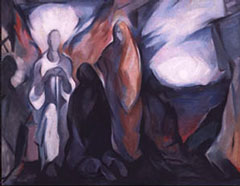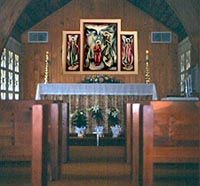


Epiphany Mission
Episcopal Church
62 Mountain Ave West
Sherwood, Tennessee 37376
(931) 598-5753
Rev. Lucy Shetters, CSM — Vicar
Episcopal Church
62 Mountain Ave West
Sherwood, Tennessee 37376
(931) 598-5753
Rev. Lucy Shetters, CSM — Vicar

Using the Phoenix as its symbol for resurrection, Epiphany Mission was rebuilt by 1964. But it would be 2001 before a sense of completion would come to Epiphany Mission.
In 1953/54 while working on the triptych for Epiphany Mission, Philip Perkins had painted a half-size study. On Easter, 2001, forty-seven years after the original was presented to the church, the Study for the Epiphany Mission Triptych was presented to Epiphany Mission in Philip Perkins' memory. Along with the triptych, Epiphany Mission also received the Perkins painting The Three Marys, depicting the morning of Christ's resurrection.
A member of the church who remembers the old stone church and the original triptych has said, "In the fire we lost everything, our church, the mementos, the memories. It's as if a part of our past is coming back to us."

Top: The study for the Epiphany Mission triptych by Philip Perkins, c. 1953, oil on canvas, center pael 40" x 28", side panels 30" x 10". Photo by Dan Hardison. The study is a half-size rendering of the triptych that was installed in Epiphany Mission in 1954. The center panel shows the same depiction of the Baptism of Christ that was in the final version. St. John the Evangelist, although depicted with the same image as in the final version, is shown on the left in the study in place of St. Francis. St. Francis was apparently a later addition because of the Mission Garden. The right panel in teh study appears to have an early version of St. John the Evangelist that was not used in the final version. In both images of St. John, he is depicted holding a chalice with a serpent emerging. The depiction of the Baptism of Christ was chosen because it is one of the events that is commemorated on Epiphany.
Above: The Three Marys by Philip Perkins, c. 1958, oil on canvas, 29" x 36". Photo by Dan Hardison.
Below: The triptych in the Mission church today. Photo by Dan Hardison.
